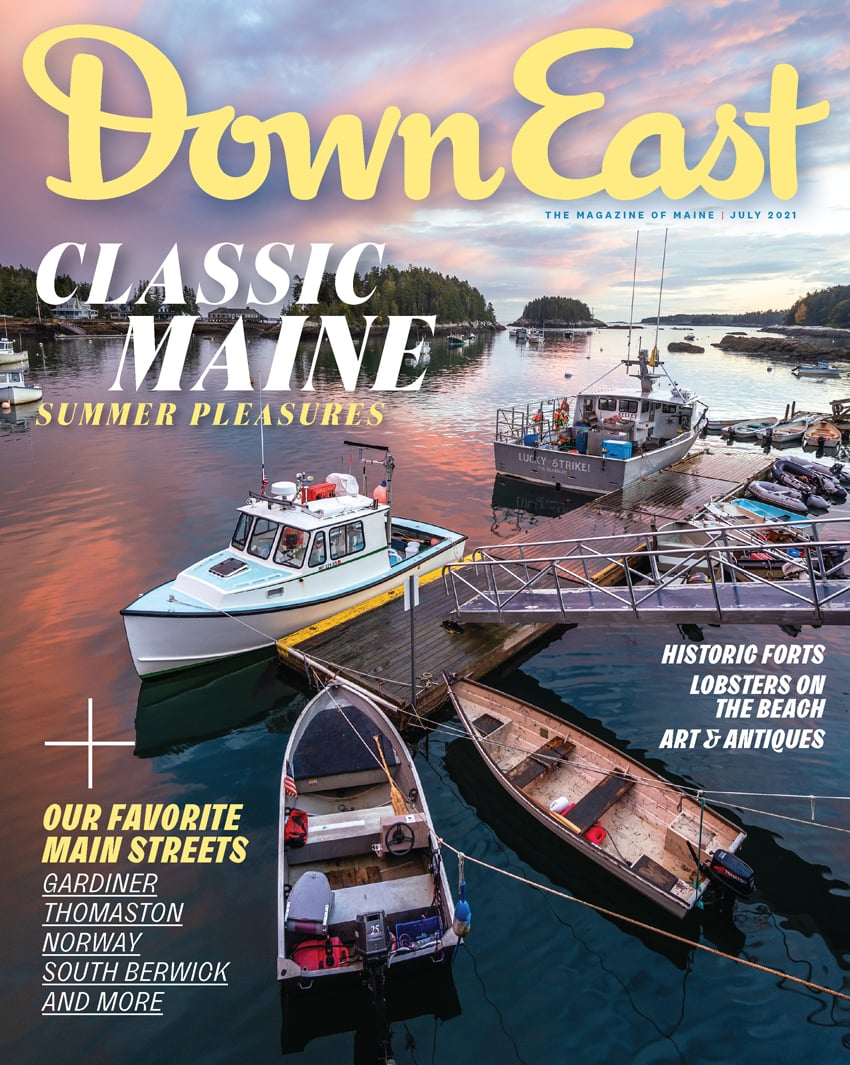By Brian Kevin
Photographed by Michael D. Wilson

Main Streets with moxie! In our July 2021 issue, we took a look at six of our favorite downtowns from all across the state — and the businesses, buildings, and boosters that make them great. Read up on more of Maine’s best small-town downtowns and start planning your next road trip.
Street Smarts

Wander long enough around small-town Maine and you’re bound to stumble into a Museum in the Streets, one of a series of open-air exhibits consisting of museum-quality placards unravelling the backstories of curious landmarks, little-known local luminaries, and historical happenings. The surprisingly captivating installations are found in more than a dozen towns across Maine and the Northeast, but the first was installed in Thomaston, in 2002, the brainchild of a former museum administrator in neighboring Cushing. Thirty panels introduce passersby to “The Town That Went to Sea,” shedding light on Thomaston’s shipbuilding heyday and lime-burning industry and the 178-year tenancy of the Maine State Prison, which relocated the same year the Museum in the Streets went up. Placards downtown include one on the picturesque twin steeples of the side-by-side Baptist and Episcopal churches and another on the architecture of the Main Street business block, with its impressive 19th-century commercial facades. Find a map and guide on the side of the Thomaston Cafe, on the corner of Main and Knox Sts.




Clockwise from top left: history buffs come to Thomaston to visit the General Henry Knox Museum, about a mile from downtown, a fascinating reconstruction of the Revolutionary War general’s home; characters lounging inside Thomaston’s Watts Hall, donated to the town by Captain Samuel Watts in 1890; the downtown Thomaston business block; Civil War monument on the grassy Main Street Mall, at the edge of downtown.
Three Squares

Two good reasons to grab breakfast from FlipSide Coffee (189 Main St.; 207-354-5221). #1: It’s where the locals go. “On any given day, I would say we know the names of 85 percent of the people who come in our doors,” explains Amanda Gaudet, who opened the coffee shop and café with her husband, Neal DeYoung, at the tail end of 2019. #2: The FlipGriddle, an egg patty stacked with applewood-smoked bacon and covered in melted cheddar, between two light, maple-infused waffles — a whole damn handheld brunch. Pause to admire the huge steel vault door from when the building housed a bank.
Lunch is down the block at the stalwart Thomaston Cafe (154 Main St.; 207-354-8589), a brasserie-ish spot that’s anchored downtown since 1990. Burgers and steak frites are specialties, paired with a Maine craft beer from the well-stocked bar. Grab the front window seat for Main Street people watching.
Across the street, the Block Saloon (173 Main St.; 207-354-5145) is more bar than restaurant, with a slate of inventive craft cocktails and a small, sophisticated wine list. But the small plates on the ever-changing menu are no mere bar snacks, and a few shared dishes of beautifully plated oysters, mushroom risotto, venison meatballs, or lobster tacos make a fine dinner in a stylish setting. The room — another former bank — is all dim lighting and exposed brick, with a handsome old skiff hanging over the bar. Cozy patio out back too.


Left: a bar seat at the relaxed Thomaston Cafe is a fine spot for lunch, dinner, or a drink. Right: a quesadilla and a steak sandwich grace the bar at Thomaston Cafe.
Market Conditions


Left: a mural behind Thomaston Grocery. Right: inside, the grocery’s deli counter.
In the 1950s, says lifelong Thomaston resident Bill Hahn, who chairs the town’s economic development committee, downtown had “two drugstores, four grocery stores, a newspaper store, a hardware store, a five-and-dime, a clothing store, and at least one restaurant.” The biggest of those groceries, Hahn says, was maybe 2,000 square feet. Then a 10,000-square-foot supermarket opened in Rockland, and as more big-footprint retailers opened up down the road, the little guys in Thomaston all folded — all but one. Woodcock’s Market survived until 1966, when new owners renamed it Jameson’s Market. Jameson’s hung in there until 1992, when current owner John Vigue took the place over and called it Thomaston Grocery (193 Main St.; 207-354-2583). Nearly three decades later, the store still thrives, known for its top-notch meat and fish counters and its savory, secret-recipe baked beans, sold by the pint or quart on Saturdays. Plenty of Thomastonians, including Hahn, consider it their primary stop for provisions.
“We’ve got a Walmart right down the street, and still people come to this grocery to do their daily shopping,” says FlipSide Coffee’s Gaudet, whose shop is next door. “You go in there, and it’s like a party — everybody knows each other.”
When the Circus Comes to Town

When newly hired economic-development specialist Brian Doyle started his work in Thomaston last winter, he knew one goal was envisioning downtown events that would bring people to Main Street as gathering restrictions eased. Already in the works was the Zerbini Family Circus (July 23–25, two shows each day), which pitches its open-sided big top on the Thomaston Athletic Field, a couple blocks behind Main Street, for a weekend of jugglers, clowns, and high-flying acrobatics.
The longer-term plan is to amp up cultural offerings at the stately, hipped-roof Watts Hall, built by Captain Samuel Watts and donated to the town in 1890. “It’s sort of the centerpiece of the downtown and always has been,” Doyle says. Town Hall moved out of Watts Hall last year, and with administrative functions out, Doyle and others hope the second-floor performance hall can start hosting concerts and other events. For now, the big draws are shows put on by the Watts Hall Community Players and the town’s annual winter sock hop.




